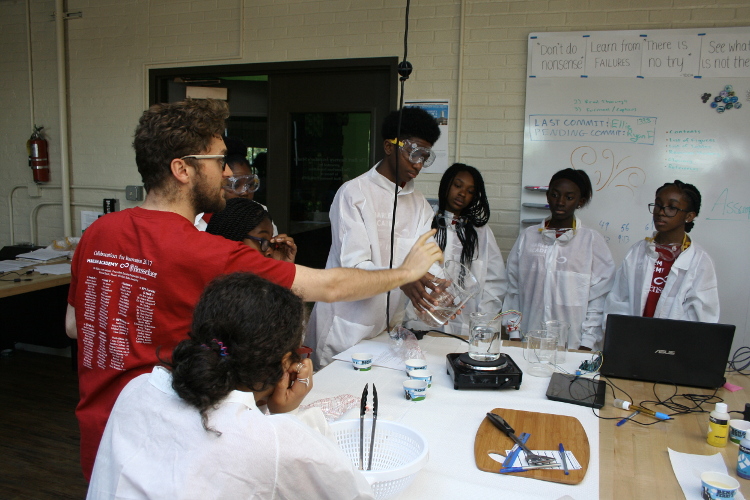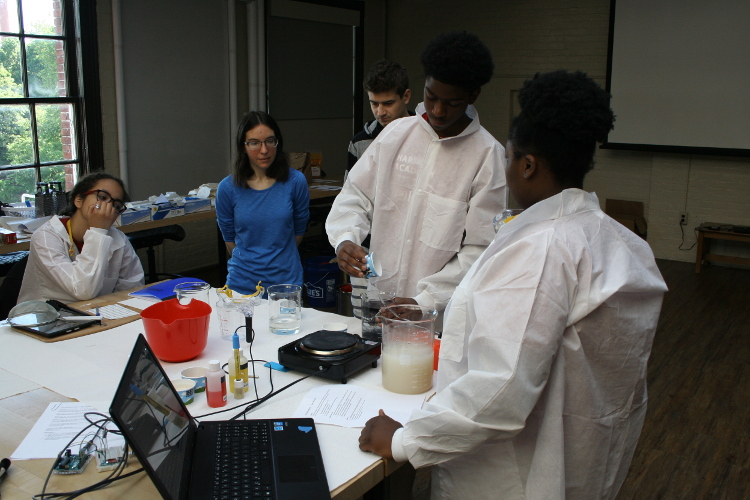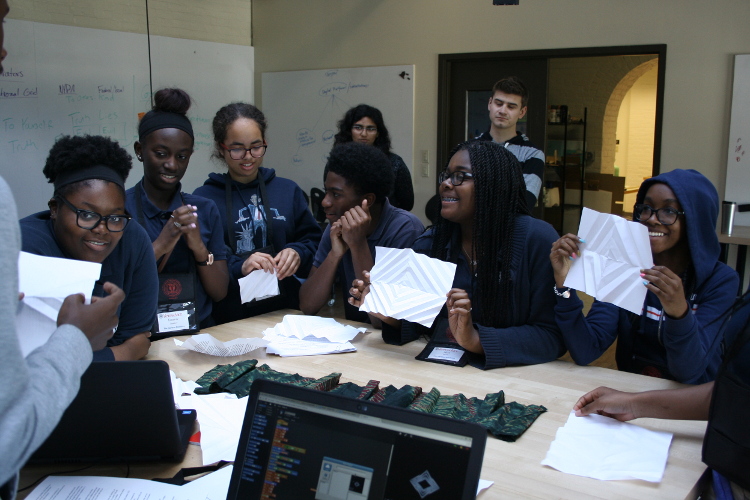Harlem Academy @ RPI, 2017
June 10, 2017

Author: bbabbitt
Over the past several years, it has been NSF Triple Helix and now NSF C-STEM's honor and privilege to host a group of Harlem Academy students during their annual visit to the RPI campus. During the first week of June, HA students and C-STEM Graduate and Undergraduate Researchers spent time together, learning about the use of scientific experimentation to provide a generative approach to textile dyes. (Above) Workshop leader and C-STEM Graduate Researcher Leo Matteo Bachinger supervises a chemical reaction useful in natural dye making with lab coated HA students.
The Harlem Academy students began their research, learning about the problems created by the synthetic dye industry and contrasted this with the ecological and cultural value generated by natural dyes and artisanal labor. They began to theorize why synthetic dyes are used so widely, where natural dyes are not. They learned about the pollution generated by the synthetic dye industry, which occurs mostly in the developing world.
The research conducted to develop this workshop can be found in one of our newest CSDT's: Sustainable Dyes.

Students then used simulation software to learn how artisans might work to dye fabric. These experiments with virtual designs helped to inform their physical designs. Students were assisted by C-STEM Staff Programmer James Davis (standing left) and C-STEM Undergraduate Researcher Obeng Buo (standing right).

Next, the students experimented with natural dyes to see how chemistry can help leverage natural, environmentally and socially just resources for dye making. C-STEM Graduate Researcher Amelia Peterson and Undergraduate Researcher Dagen Braun (standing in background) assisted the students as they ran their experiments.

As part of the dying process, it is important to know about the pH of the dye components in use. Leo Bachinger instructs students to use pH probes attached to the Arduino Microcontroller, hooked up to a data visualization web page on the laptop. The probe measures the hydrogen ion concentration when inserted into the liquid. This measurement is reported to the Arduino and displayed on the laptop as a measure of pH (how acidic or basic the substance is).

The students considered how they would apply the natural dye to the fabric swatches provided for the physical rendering. One way indigenous artisans apply the dye to create a design is to fold the cloth and use clamps to restrict where the dye can absorb into the material. Obeng Buo leads a group of students as they fold paper in preparation to dye their fabric. Obeng is assisted by Undergraduate Researchers Anegi James and Dagen Braun (standing behind).
 Another way that dye is applied to fabric is through stamping. For example, artisans create Adinkra cloth, a product of Ghana, West Africa through stamping ink on fabric. The actual Adinkra stamps are hand carved, but in our case, the students explored 3D printing their Adinkra shapes. Postdoctoral Researcher Bill Babbitt works with students as they finalize and print their Adinkra stamp designs.
Another way that dye is applied to fabric is through stamping. For example, artisans create Adinkra cloth, a product of Ghana, West Africa through stamping ink on fabric. The actual Adinkra stamps are hand carved, but in our case, the students explored 3D printing their Adinkra shapes. Postdoctoral Researcher Bill Babbitt works with students as they finalize and print their Adinkra stamp designs.

The third way to dye cloth that the Harlem Academy students explored is to first mechanically apply some sort of resist material, such as wax or glue. This resist material restricts where the dye can adhere to the cloth fibers. Above, C-STEM Graduate Researcher Amelia Peterson explains the "Batik Bot" machine that she invented (Amelia on the right, Batik Bot immediately to the left). The Arduino Microcontroller controls the positioning of the surface (round disk) and the application of glue to the cloth.

Students and their final project using the fold and clamp method for dying cloth.

Students and their final project using the mechanical Batik Bot method for dying cloth.

Students and their final project using wax as a dye resist and Adinkra stamps.